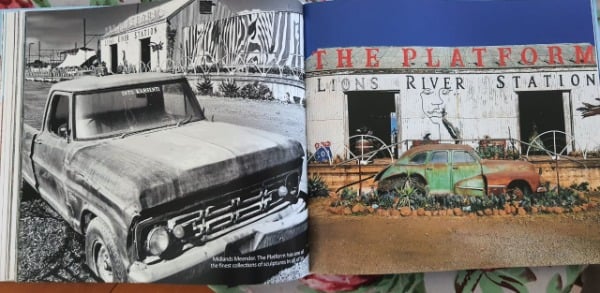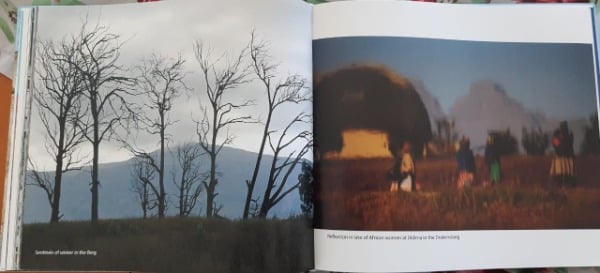
This reader’s impression was written and sent to LitNet on the writer's own initiative.
...
Karoozing is one of those books that comes into your life and makes your soul dance.
...
Karoozing is a photobook by academic, hodophile and Meanderthalman Darryl Earl David.
In the picture “Midlands mirth” (in KZN Midlands and the Berg) there is a sign on a farm gate which reads “Trespassers will be shot. Survivors will be shot again” But there are other gates in this “ode to the open road” which invite you to trespass gladly. Whether it is the nostalgic reopening of a farm gate in Uys Krige’s poem “Plaashek” or the invitation to enter the town of Hanover expressed in the friendly smiles of the children with, significantly, a car approaching from the background, or the vistas stretching to inviting distances in a number of pictures, this book is full of “gates” of varying kinds. And on every page of this book of outstanding photos, the camera lens is the gate which invites the participating observer to travel the open road with the creator of this volume, Darryl Earl David.

Travel is a recurring theme in the book: “Travel with no regret” (Oscar Wilde). “To travel is to live” (Hans Christian Andersen). “Life is beautiful if you are on the road to somewhere” (Orhan Pamuk).

There are no page numbers, which, according to David, is to avoid the travelling observer being pinned down, but also so as not to spoil the photos (though there are, of course, captions to most of them). The reader as medereisiger, as fellow traveller, is encouraged to page on and on to fulfil the almost breathless expectation created by the thematically arranged geographical sections: from the Karoo, then through Landscapes of the Heart, to the KZN Midlands and the Berg, along the Garden Route and into the Cape where you can “borrow” Koos Kombuis’s bicycle sonder ’n slot, no lock to hold you back on this bicycle-speed meander. Nothing to stop your freedom to go, to travel unrestricted on the open road, to enter through so many gates.

However – and this is what continues to engage the reader – there is a constant tension, a dynamic, throughout the book between the ideas of motion and stillness. This is An Ode to the Open Road (the sub-title), but each photo is also an ode to beauty which makes the reader pause, stop, and admire (for example, the human figures sitting atop a mountain and gazing out over the beauty of the whole range stretching into the distance). But then the reader/traveller wants to turn to the next page, invited to do so by the breathtaking beauty of the photos. The stillness is exemplified best, perhaps, in photos such as the one of a child’s bicycle in the middle of a country road, suggesting that the rider has stopped, not to abandon the bicycle, but to look more closely at the scenery; in the photo of a boat later in the book, absolutely still, in the shallow but moving waters of the ocean. Stop with Darryl at Matjiesfontein or Howick or at The Platform at the Lion’s River Station. And pause and be still in the photos of and poems about houses (even in the one of an abandoned farmhouse), suggesting the need for a still place expressing proof of love for someone or contentment or the stillness of sadness at what once was.
The same tension, dynamic, asks the reader to page on quickly, but to stop and breathe in for a still moment at what each page presents. To stop and ponder the creative genius of David contained in each caption, poem, song, or quotation by so many other writers.

Darryl David’s alter ego is the Meanderthalman which he uses in the newspaper articles on various stops he has made on his meanders. Fascinating though his explorations of these places are, they are not easy to explore with him as the print is rather too small and at times difficult to decipher. You don’t really stop there – that tension again between going and pausing – but without the fulfilment of so much else on the journey.
The pun in the title Karoozing points to moving, but the picture of the karretjiemense and Clinton du Plessis’s poem about them indicates that there can be no cruising at speed in paging through the book, but moving with the slow, deep contentment of the pace of the donkey cart. A donkey cart, self-built, with tattered hands (met flenter hande), which even has a number plate to prove it exists. And then the gentle irony of the child in the cart with a cell phone with WhatsApp function. A traditional way of travelling the open road, but it’s in the now – it must be seen, acknowledged.

Although David quotes Gustave Flaubert: “Travel makes one modest. You see what a tiny place you occupy in the world”, karoozing with Darryl David to so many wondrous places, sometimes perhaps not-known-about-before places, makes one realise to what extent one is inherently part of the world, part of its beauty and its greatness. What better picture to indicate this than the one with the caption “Reflection in lake of African women in Didima in the Drakensberg”, where the deliberate blurring shows that they are inseparable from the landscape; that, as humans, they, and we, belong in and are inseparable from, the world, and not as tiny as Flaubert suggests.
David quotes renowned photographer Annie Leibovitz: “I wish that all of nature’s magnificence, the emotion of the land, the living energy of place could be photographed.”
What Leibovitz wishes for is realised by Darryl David when he quotes and echoes JM Coetzee:
Hunger, I thought: It is a hunger of the eyes I feel, such hunger that I am loath even to blink. These seas, these mountains: I want to burn them upon my sight so deeply that, no matter where I go, they will always be before me. I am hungry with love of this world. (Age of iron)
Norwegian architect Christian Norberg-Schulz, in Genius loci: towards a phenomenology of architecture, talks about the genius loci, the prevailing character or atmosphere of a place, the presiding god or spirit of a place. The beautiful photographs in Karoozing and their captions capture the genius loci of each place, make you see the spirit of the place, see what makes each place the place it is, even in the found-it-in-the-middle-of-nowheres to which Meanderthalman, his wife and daughter have gone and to which they have taken us as willing fellow-travellers.

The final location on the journey (just before we are invited take a sip of “one for the road”) is, gloriously, a return, which we take with a gulp of joy, to the beginning, to the Karoo, to its cathedrals, where every spire of every church, each pointed window or pinnacle points to what a Karoo farmer once told Darryl: “This is the place where God comes to think.”
Karoozing is one of those books that comes into your life and makes your soul dance.
See also:
Seen elsewhere: What highs have we not experienced in Afrikaans literature

